Post Mortem Preview
Microids is following up on the critically acclaimed Syberia with another promising adventure game. We get new details on Post Mortem straight from the developer.
Following up a success may be an enviable problem to have, but don't try to convince Stephane Brochu of that right now. The Microids designer is currently hard at work leading the development team on Post Mortem, the first adventure game from the company since Syberia earned critical raves and became a cult hit last summer in Europe. While the forthcoming game isn't a sequel, it carries with it the high expectations of adventure fans looking for the same high quality evidenced in its predecessor.
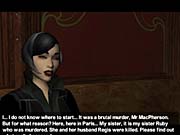
Looking at a late beta build makes us think that meeting those expectations might not be much of a problem. More than a month away from its prospective release date in North America, Post Mortem already bears all the hallmarks of a memorable adventure. Those looking for a game in the tradition of Syberia, however, are likely to be disappointed. Brochu's current project is different in almost every way, veering away from Benoit Sokal's slightly surreal fantasy and into a pulp-fiction world of private eyes, mysterious dames, and whispers of the occult.
"Post Mortem is in the proud tradition of film noir and the gritty detective stories from the 1920s and 1930s, but it also has a touch of other 1920s writers," Brochu explained. "People like [HP] Lovecraft and [Arthur] Machen are represented, and why not? They both wrote in roughly the same era as the classic crime noir authors, and to us it seemed like a natural mix. There is even a hint of Poe."
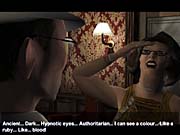
Specifically, the setting is Paris in the 1920s. You assume the role of Gus MacPherson, an ex-private eye from New York City who has traded in his gun and the Big Apple for a paintbrush and the Left Bank. This dissolute take on retirement ends as soon as he meets Sophia Blake, the standard noir dame with a problem. In this case, the problem is the recent grisly murders of her sister and brother-in-law in a Paris hotel. She lures the impoverished MacPherson away from his easel with promises of cash, and soon the former detective is back on the job, scouring Parisian nightspots for a killer. That job isn't easy. The ritual beheading of the couple, along with vague occult overtones, make this more than a typical murder case, and MacPherson is soon neck-deep in conspiracy theories and suspicion. Making matters even stranger is a series of frightening, violent psychic visions that he experiences whenever he gets close to people and places connected to the killings.
This story will be told using Microids' new "natural dialogue" engine. MacPherson is given a number of possible directions whenever he begins a conversation. For example, when he questions an obnoxious hotel clerk about the murders, he is given the option of telling the truth or making up a false identity and claiming he's an insurance investigator. Success or failure is never a given in the beta build, as there seem to be no absolutely right or absolutely wrong dialogue paths. Befitting the name, the natural engine creates natural conversations, in which you can start off trying to cover your identity and find that the resulting discussion ends up in an area you didn't anticipate. Telling the hotel clerk that you're an insurance investigator simply allows him to indignantly present you with the outrageous bill that the late couple ran up prior to their untimely demise.
Choose Your Words Wisely
"The natural engine allows us to have much more dynamic conversations, cutting between the two characters and having a wide range of different camera angles," Brochu said. "When talking with an NPC and trying to lure information from him or her, you'll be able to take different approaches to get what you're looking for. Will you lie, will you give portions of the truth? You draw the cards."
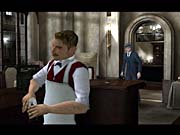
A side benefit of the natural engine should give Post Mortem some replay value. As you have to commit yourself to a specific story whenever you begin talking to another character, there is no way to backtrack and try alternate approaches without restarting the game. In the beta, you can go through the game one time as a hard-boiled detective, grilling everyone as if they were suspects, and then again as a sly liar, concocting different stories for every character you meet. Conversations can be dramatically different depending on the approach you use, providing more or less information depending on how well you read the other person. What you do can also effect how you reach the conclusion, and the conclusion itself, as there will be multiple endings. Because of all this, the stakes seem higher than they do in the typical adventure game, where you can usually run through all the dialogue-tree options before ending a conversation. After visiting a few likely suspects in the beta, we realized that one false move could result in gaining little or no information. This attaches great importance to every dialogue choice and seems to add a strategic dimension that goes beyond what adventure games typically offer.
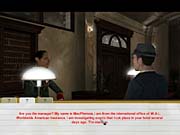
Such dialogue is also giving Brochu the option to further diverge from the Syberia style. As he explains it, "Syberia is more of an exploration game, where the story takes you to new locales in order to move forward. Post Mortem is more of an investigative game, where you need to go back to the same locations and talk with people. They both have elements of the fantastic, but in Syberia, the fantasy aspect is in the technology. In Post Mortem, the fantasy element is somewhere closer to home. The mystical, magical, and esoteric aspects of history and of the corridors of power are explored."
The characters in Post Mortem appear to be as distinct as the natural engine that powers them. In the beta, we encountered a wide range of Parisians who ran the gamut of people you might expect to find in the city between the wars. The most significant member of the cast seems to be your client. Sophia Blake is the typical film noir detective's client, a sexy but slightly odd woman who can't be completely trusted. In another nod to traditional film noir, MacPherson and Blake strike up a relationship that appears to go beyond the purely professional. Other personages in the game are equally peculiar. In the early stages of the beta, we ran into the arrogant hotel clerk mentioned above, a flaky psychic who may or may not have seen the killer, an alcoholic cop who demands booze before opening up his files, a gambling-addicted bellboy who clearly knows more than he's willing to say about the murders, a shrink who hints at the profoundly disturbed mind behind the gruesome crime, a lady of the night who seems to have more than a passing acquaintance with our hero, and a shady bistro owner who may be involved in organized crime. All of them work together to create an effective noir environment in which you're not really sure of anyone that you meet. As Brochu said, "Like in any good film noir, you won't know who really wants what from you until the very end."
A Puzzling Proposition
Figuring out who wants what will be the principal focus of Post Mortem, but it won't encompass the entire game. In addition to querying suspects, you will also have to solve a few puzzles. Judging from what we've seen in the beta, these conundrums will vary in subject and difficulty. At one point, MacPherson needs to hide in a steamer trunk in order to make his way upstairs to the hotel room where the murders took place. That's a pretty standard adventure game problem to solve, though having to manually pick the lock on the room door once you get upstairs isn't typical. Other interesting challenges also presented themselves in the beta. When trying to get the cooperation of the dubious bistro owner, MacPherson has to use his knowledge of the art world to compare a forged copy of a Hieronymus Bosch painting to the real thing and circle the missing elements. And while you're hunting for the killer, you can use MacPherson's skills as an artist more directly by drawing a sketch of the suspect to show to possible witnesses. This works in Mr. Potato Head fashion, as you choose from a variety of different facial features and try to build a face similar to the one that people have described. A maze and an encryption puzzle will also be in the final game.
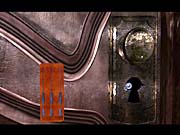
MacPherson's legwork and puzzle solving will take place in and around a number of well-realized Paris nightspots. In addition to the wannabe artist's hovel, in the beta you get to visit a ritzy hotel, a forbidding psychiatric institution, a swank bistro, a chic restaurant, a dank police station, and more. All the locations are dark, befitting both nighttime Paris and the gloomy plot. You interact with your surroundings from a first-person perspective, swiveling the mouse a full 360 degrees to look at what's in the immediate vicinityMoving the mouse cursor allows you to interact with objects, begin conversations, or simply walk to a new location. If the cursor is in a location where you can do something, it changes. Gears indicate that an item can be manipulated or picked up, a megaphone tells you that you can have a discussion, and feet show that you can move in that direction. Your inventory is called up with a click of the right mouse button. Using objects that you have obtained is then as easy as clicking on them.

The graphics engine powering Post Mortem draws background sequences in flat 2D and characters and foreground objects you can interact with in 3D. The former seems fairly sharp, though static, in the beta. The artwork is well done, although there is a certain lifelessness in it that both accentuates the grim story and makes everything seem less realistic. The character models are very well done. The game switches to a third-person view whenever a conversation starts, allowing for the use of cinematic camera angles that pan around MacPherson and his subject and further establish a film noir mood. A lot of little touches are evident in the beta. Characters fidget as they would in real life, running their hands through their hair, restlessly moving their arms, and so forth. And all the spoken lines are voiced by solid voice-acting talent. The actor portraying MacPherson is particularly good, giving the slight, bespectacled investigator an understated presence that seems to perfectly fit this part.
You'll be able to check out Post Mortem for yourself before the end of the year. A firm North American release date has yet to be announced, although Microids is presently looking at sometime in December. Check back with GameSpot for full review coverage when the game hits store shelves.
Got a news tip or want to contact us directly? Email news@gamespot.com
Join the conversation